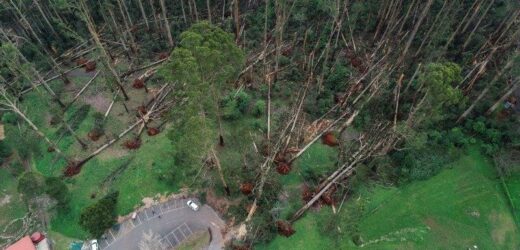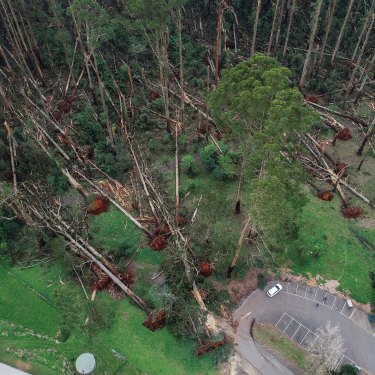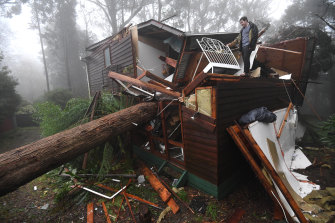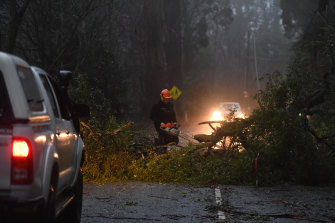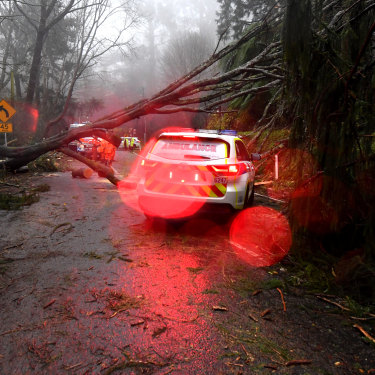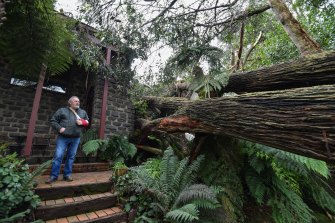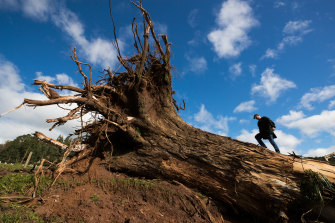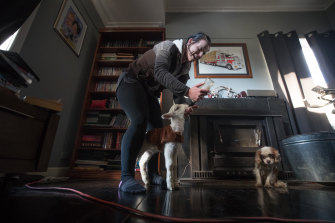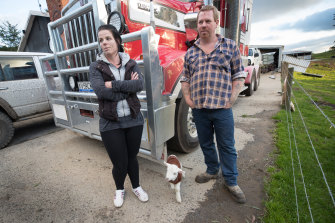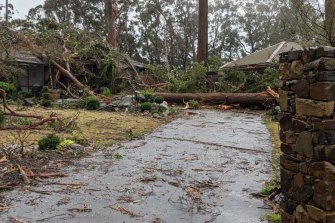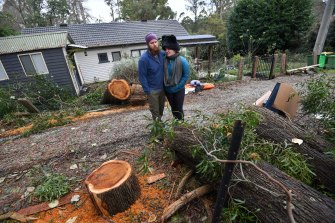By Tom Cowie, Benjamin Preiss and Erin Pearson
Massive trees fell like ninepins near Mount Dandenong Primary School. Credit:Joe Armao
The windows really started to rattle just after dinner. Weather forecasters had predicted strong winds that day, but by 9pm the trees heaved with a sustained violence that would not let up until after sunrise.
For those in the picturesque Dandenong Ranges, it felt as if the whole mountain was shaking. In Gippsland, which was hit first, it was worse than a cyclone. Central Victoria was not spared either.
A screaming sound filled the air as high-speed south-easterly gusts whipped through the canopy’s leaves and branches.
Then the trees started to fall, like soldiers fainting on a long march. There was no chance of sleep, just the awful wait to wonder where the next one would land and what would be underneath it.
Trunks and limbs crashed down for hours, cutting buildings in half. Roads were blocked and power poles smashed as more than 200,000 homes and businesses had their electricity cut.
A tree through a house in Olinda.Credit:Joe Armao
The storm brought rain too, enough to flood parts of Gippsland and compromise the Yallourn power station. The heavy falls, combined with an unusual wind direction, wrought terrible destruction across Victoria, killing two people.
Those who experienced the wild night and morning of June 9 and 10 say they have never seen or heard anything like it. More than a week later, power lines are still draped over trees and strewn across the roads.
The aftermath has raised questions about how communities can be protected from unexpected weather events, which are set to revisit more often due to climate change, and whether the worst could have been avoided altogether.
Chris Arvier, senior meteorologist at the Bureau of Meteorology, describes the storm that smashed Victoria last week as “very very unusual”.
SES and CFA volunteers cleared trees throughout the night from the winding roads of the Dandenong Ranges.Credit:Joe Armao
But while the gusts were brisk (119 km/h at Puckapunyal the highest), they weren’t the strongest ever recorded. What made this wind different was the direction.
Normally, Victoria’s high winds blow from the north or north-west, or sometimes the south-west during winter. On that night they came in from the south-east, off the Bass Strait. It was like attacking the trees from behind.
There was also plenty of rain, with 271 millimetres falling on the Dandenongs alone.
“The trees do get accustomed to growing to protect themselves from where they expect the strongest winds to be,” Arvier says.
“We also get precipitation loading – the rain is falling into the branches, increasing the weight and making everything a bit heavier. That means they can fall over a bit easier.”
‘Trees like pick-up sticks’
As the wind swirled around their Kalorama house that night, Thomas Corbin told his wife Samantha to imagine they were on a beach: the noise was nothing more than waves crashing to the shore.
“We were looking through the window and it was so loud you couldn’t hear the trees coming down,” he recalls.
They moved from room to room in their house until 5am, hoping to dodge the trees as tall as buildings that had already flattened their car.
A fallen tree delays emergency service workers in Olinda.Credit:Joe Armao
“Our car was crushed to the ground and we didn’t hear it,” he says.
One of the tall blackwood trees eventually crashed onto their roof, smashing up tiles but stopping short of damaging the ceiling. But many of their neighbours, like John Carlyle, fared much worse.
It was 2am when the first of the enormous trees slammed through his lounge room as he lay in bed.
“I was only three or four metres from it,” he says. “On the other side of a solid stone wall.”
Another hit his studio, where he paints intricate landscapes. Within 30 minutes, three more collapsed onto his carport.
Days later, the trees still rested inside his house: a mess of bluestones, insulation batts, wooden beams, sodden carpet and leaves.
Told by police and firefighters that the structure was unsafe, Carlyle is determined to stay with his cat, Sam, until his home can be properly locked up, despite the obvious danger.
“If a tree takes me, it takes us both,” he says.
As the rain poured down at 1.30am, Emerald SES Unit Commander Ben Owen pulled his crew off the mountain. It was “hell on earth” trying to navigate the thin, winding roads of the hills with trees dropping all around them.
“They were the biggest monsters around, not your garden variety tree,” he says. “They were eucalypts – 80, 90, 100 years old.”
One had already smashed into a SES vehicle, just metres from hitting the volunteers standing nearby. Back at the station, the notification pager buzzed with job after job but there was no point reading it as the conditions were so unsafe.
“We were just deflated, we had people who needed us,” he says.
The road closures forced some emergency volunteers to sleep on floors in houses on the other side of the mountain, unable to get back home to their families.
“People were in their homes praying, trying to figure out where to hide,” Owen says. “Is it under the stairs? Is it in the bathroom? Where is the furthest place from that big one outside?”
John Carlyle inspects the damage in Kalorama.Credit:Joe Armao
Kalorama CFA captain Bill Robinson likens the aftermath to that of the Black Saturday bushfires because of the number of crushed cars and blocked roads.
He and the rest of the volunteers were called in at 9.45pm, with the first rescue at nearby Erith Lane. But when they got there, a tree was blocking the road. And then another one fell behind them, forcing the crew to turn back.
Hundreds of trees were cut through with chainsaws that night, he says, with danger still looming above the crews. Short journeys took hours, with some roads blocked every 10 metres. He’s amazed that no one was killed in the Dandenongs.
“I was running on adrenaline, I did have a couple of thoughts about ‘we’re in a bad situation here’,” he says.
“The trees were pick-up sticks, that’s what it looked like, on a giant scale.”
Without power for weeks
The storm rolled on to central Victoria, particuarly Trentham and Woodend, where many woke to find themselves cut off from the outside world without power or phone services, trees piled high in their driveways.
Neighbours banded together to cut one another out of their homes, as power companies worked around the clock to get everyone back on the grid.
“I’ve been here 35 years and I’ve never seen anything like it,” says Powercor Kyneton field leader Gary Scanlon. “Normally a storm leaves a narrow strip of damage, but to impact the whole district like this is unheard of.”
Will Kanavan stands on the stump of a gum tree on his Yinnar South farm.Credit:Jason South
In Gippsland, the initial emergency effort focused on homes being flooded, as the Traralgon Creek rose almost five metres and inundated homes.
However, while the receding water at Traralgon left behind a trail of thick brown sludge in houses near the creek, the rural properties further south fared even worse.
Kat Gration had already noticed the wind was blowing hard on the school pick-up. Some trees and lines had fallen across roads, however she journeyed home to a rural patch of Mirboo East not expecting to be trapped there for four days without power and running water.
At 11.20pm, she and husband Brenton woke up to a large bang. There was also the sound of metal tearing from rooftops and glass shattering.
“I looked out the window and saw the powerlines smashed up all around the house,” she says. “The trees were so thick across the driveway we couldn’t get out on foot. There were just walls of trees down everywhere, massive landslips down on the roads.”
Kat Gration and her family were stranded for days with no power, no food and having use water out of the horse trough after the storm devastated their property. Credit:Jason South
Unable to get out, they were forced to boil water out of their horse trough for their three young children to drink.
A friend eventually crossed through nearby creeks and paddocks to offer help, as the family fried what bread they had left on a gas camping stove.
Power crews arrived eight days later, white-faced after learning they nearly turned the power on to the whole area without knowing the Gration family still had lines strewn across their land.
“He told us they nearly killed our whole family. It would’ve livened up all the paddock and everything,” says Gration.
“There was water all over the ground and lines wrapped all over the gates and all through our paddocks with horses and across the driveway.”
They’re now facing up to a six-week wait for power to be restored.
Brenton and Kat Gration are facing a wait of up to six weeks for power on their Mirboo East property.Credit:Jason South
Despite being hit first, locals say the Latrobe Valley in central Gippsland has had the least attention during the rescue and clean-up effort. At the height of the chaos, their own emergency services were diverted to Traralgon and further afield while they were told to fend for themselves.
Latrobe City mayor Sharon Gibson pleads for the urgent deployment of ADF troops to save her battered region from a trifecta of issues – floodwater, destructive winds and now erosion.
“It’s not going good down here,” she says. “We’ve got bridges still being washed away. It’s a disaster. We need the army.”
Ten days later, thousands of people are still without power in both the Dandenongs and Gippsland. It is expected to take weeks for crews to rebuild the poles and wires taken out by the storm.
Power supplier AusNet, which handles the eastern part of Victoria, has had to defend the delay in restoring electricity, initially telling customers most would be back on soon, before apologising and saying it would be three weeks or more.
On The Crescent in Sassafras, power lines are draped across the road a week after a large tree snapped a concrete pole in two.
The rickety hum of petrol generators echoes through the hills, with discussion on Facebook groups about the etiquette of running one late at night.
A power pole snapped in half in Sassafras.Credit:Eddie Jim
Alex Koehler shakes his head as he looks at the fallen power lines outside his house, bringing up a text message from AusNet telling him that electricity is likely to be restored the next day.
“They sent me a message saying that ‘we’re hard at work, blah blah blah’,” he says. “It’s going to be at least a week from here.”
Why did so many trees fall?
Many of the locals that The Age visited this week spoke about how unusual it was for the wind to blow from the south-east and whether that contributed to the number of trees falling.
Melbourne University arboriculture expert Dr Greg Moore says trees develop root systems over time to withstand winds that come from typical directions.
He explains that 60 per cent of a tree’s root mass will grow to meet oncoming winds – in the case of the Dandenongs, often westerly.
Damage in the Dandenong Ranges.Credit:CFA Media
But Moore says wind directions are becoming more unpredictable because of climate change and during last week’s storms they tore through the Dandenongs from the south-east.
He says sudden rainfall that softens the soil combined with increasingly strong winds blowing from atypical directions results in trees crashing to the ground in extreme weather. In forestry parlance, the trees were “windthrown”.
“What you’re seeing is the predictions of climate change that were made the best part of 30 years ago coming to fruition,” he says.
Moore argues that power and telecommunications cables should be buried underground in areas with both large trees and somewhat dense populations, including the Dandenongs, where there is fire and storm risk.
Some were lucky the trees fell the other way in Sherbrooke.Credit:Eddie Jim
But he concedes this would be much more expensive than the current system of wires hanging from poles across most of the state.
And while it is not always possible to bore deep enough to prevent damage to the root systems of trees, Moore insists the soil conditions and root depths will allow for underground wires in the Dandenongs.
After Black Saturday, the Victorian Bushfires Royal Commission recommended that powerlines be put underground in the areas of greatest bushfire risk. Many of those same places are now dealing with this disaster.
It’s clear that putting all power underground would be a very costly exercise.
A state government taskforce established in 2010 to implement the Royal Commission’s recommendations estimated it would cost $40 billion to put power underground in non-urban areas.
When asked this week if the government was unwilling to put power cables underground as proposed by the Bushfires Royal Commission, Energy Minister Lily D’Ambrosio insisted the recommendations actually referred to a range of technologies to reduce the risk of fires from faulty infrastructure.
Thomas and Samantha Corbin no longer feel like flatlanders after living through the storm.Credit:Joe Armao
She said the government had diligently applied all the recommendations that were supported. “But we will always continue to look at options to make communities safe,” she added.
One thing the Corbins have learned after moving to Kalorama in 2017 is that living in a place surrounded by beauty also brings risks.
But they want to stay, even as they survey the trees still lying across their neighbours’ roads and power lines sagging to the ground.
Thomas Corbin says they have earned the right to be considered locals.
“If you got through this you earned your mountain folk passport,” he says. “No one’s a flatlander anymore.”
Most Viewed in National
Source: Read Full Article
